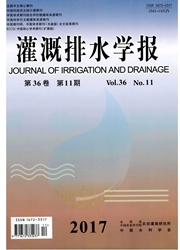

 中文摘要:
中文摘要:
采用HSPF模型模拟了东江流域1980、2000和2008年土地利用情景下的径流过程,并识别了不同土地利用类型水文效应的敏感性。结果表明,HSPF模型模拟的月平均流量的相对误差为-4.6%,Nash-Suttcliffe系数高达0.95,拟合结果良好;气候条件一致下,2008年土地利用情景下模拟的年均径流量较1980年增加了2.36亿m3,增幅为0.97%,且土地利用变化引起的月径流量的增加主要集中5-7月;土地利用变化对流域的洪水过程影响显著。耕地、林地和城镇用地对径流深的贡献系数分别为-O.0118、-0.0237和0.0118mm/km2,耕地的减少和城镇用地的扩张使径流量增加,林地面积的增加使径流量减少。
 英文摘要:
英文摘要:
The runoff processes were simulated with different land use scenarios in 1980, 2000 and 2008 in the Dongjiang river basin , and the sensitivity of hydrological response to different land use types through the HSPF model was identified. The results indicated that. the average monthly flow simulated by HSPF model had a high accuracy with the relative error of -4.6 % and the Nash-Suttcliffe efficiency coefficient of 0.95. In the same climatic conditions, the average annual runoff with land use scenario in 2008 increased by 236 million m3 (0.97%) compared to 1980. The increase of monthly runoff, caused by land use change, distributed mainly in May, June, July. Land use change had significant influences on the flood process in the Dongjiang river basin. The contribution coefficients of cropland, forestland and urban land to runoff were -0. 0118, -0. 0237 and 0. 0118 mm/km2 respectively. Thus, the decrease of cropland area and the expansion of urban land could cause runoff increasing, and the increase of forestland may cause runoff re- ducing.
 同期刊论文项目
同期刊论文项目
 同项目期刊论文
同项目期刊论文
 A Fuzzy Comprehensive Evaluation Model for Flood Risk Based on the Combination Weight of Game Theory
A Fuzzy Comprehensive Evaluation Model for Flood Risk Based on the Combination Weight of Game Theory Spatio-temporal patterns of hydrological processes and their responses to human activities in the Po
Spatio-temporal patterns of hydrological processes and their responses to human activities in the Po Impacts of climate change and human activities on surface runoff in the Dongjiang River basin of Chi
Impacts of climate change and human activities on surface runoff in the Dongjiang River basin of Chi Changing properties of hydrological extremes in south China: natural variations or human influences?
Changing properties of hydrological extremes in south China: natural variations or human influences? Multiscale streamflow variations of the Pearl River basin and possible implications for the water De
Multiscale streamflow variations of the Pearl River basin and possible implications for the water De Precipitation variability (1956~2002) in the Dongjiang River (Zhujiang River basin, China) and assoc
Precipitation variability (1956~2002) in the Dongjiang River (Zhujiang River basin, China) and assoc Statistical behaviours of precipitation regimes in China and their links with atmospheric circulatio
Statistical behaviours of precipitation regimes in China and their links with atmospheric circulatio Estimation of evapotranspiration using remotely sensed land surface temperature and the revised thre
Estimation of evapotranspiration using remotely sensed land surface temperature and the revised thre The Influence of dam and lakes on the Yangtze River streamflow: Long-range correlation and complexit
The Influence of dam and lakes on the Yangtze River streamflow: Long-range correlation and complexit 期刊信息
期刊信息
